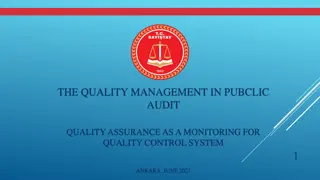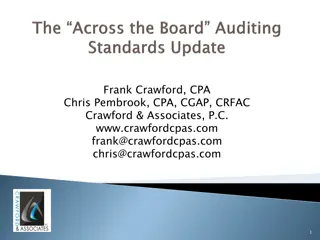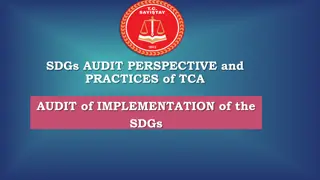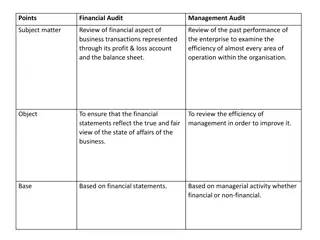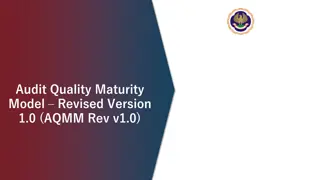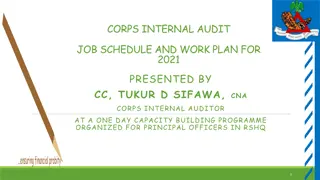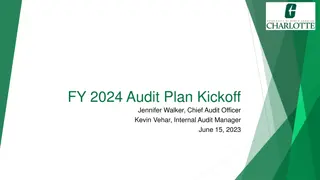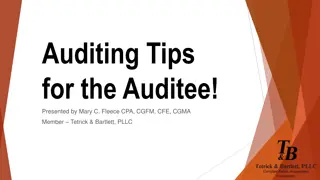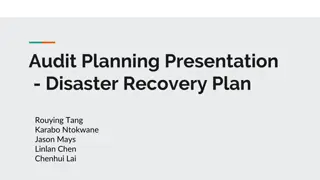Auditing Lowballing: Impact on Audit Quality and Recovery
The study explores the practice of lowballing audit fees and its effects on auditor independence and audit quality. Key research questions examine the relationship between non-audit fees, client importance, and lowballing, as well as the recovery of initial fee discounts. Hypotheses suggest connections between lowballing, non-audit fees, client importance, and future fee recovery. The findings aim to shed light on the dynamics of audit fee setting and its implications for audit quality.
Download Presentation

Please find below an Image/Link to download the presentation.
The content on the website is provided AS IS for your information and personal use only. It may not be sold, licensed, or shared on other websites without obtaining consent from the author.If you encounter any issues during the download, it is possible that the publisher has removed the file from their server.
You are allowed to download the files provided on this website for personal or commercial use, subject to the condition that they are used lawfully. All files are the property of their respective owners.
The content on the website is provided AS IS for your information and personal use only. It may not be sold, licensed, or shared on other websites without obtaining consent from the author.
E N D
Presentation Transcript
AUDIT FEE LOWBALLING: AUDIT FEE LOWBALLING: DETERMINANTS, RECOVERY, AND FUTURE DETERMINANTS, RECOVERY, AND FUTURE AUDIT QUALITY AUDIT QUALITY August 13, 2019 Myojung Cho Gopal Krishnan Soo Young Kwon
Motivation Motivation Lowballing (LB) is the practice of setting audit fees lower than total current costs during initial audit engagements (DeAngelo 1981; Kanodia and Mukherji 1994; Bruce 2010; Desir et al. 2014). Concerns of Regulators and practitioners: impact of LB on auditor independence and audit quality (SEC 1978; AICPA 1978; Turner 2002; NASBA 2010; PCAOB 2011). DeFond and Zhang (2014, 311), while commenting on LB in their review of the audit archival literature, state that this literature focuses almost exclusively on the existence of low-balling, with little attention to whether low-balling affects audit quality. This seems surprising given that regulators primary concern is the threat to audit quality Is lowballing (LB) of audit fees related to lower audit quality? Inconclusive in extant literature
Three Research Questions Three Research Questions Two important factors of auditor independence of regulator concerns: the cozy client-auditor relationship with more non-audit services and influence of large and important clients on auditors. Are non-audit fees and client importance significantly related to LB? DeAngelo (1981) argues that it is the potential for future increase in fees, rather than the initial fee cut, that impairs auditor independence. Do LB auditors indeed recoup their initial fee discount in the future years? Concerns of regulators: LB auditors who attempt to recoup their initial fee loss have stronger incentives to retain their clients in the future at the expense of audit quality in those years. Does the recovery of fees deteriorate future audit quality?
Hypotheses 1 & 2 Hypotheses 1 & 2 Hypothesis 1 Hypothesis 1: Lowballing is not significantly related to the level of non-audit fees in the initial engagement year. Positive relation: if the auditor expects to save costs from the knowledge spillover arising from its non-audit engagement (Antle and Demski, 1991; Simunic, 1984). Negative relation: an auditor and client may negotiate for lower audit fees in exchange for higher non-audit fees (Antle et al. 2006). Hypothesis 2 Hypothesis 2: Client importance is positively related to lowballing for clients of non-Big auditors but not for clients of Big N auditors. Big N auditors want to maintain audit quality due to reputation and litigations while non-Big N auditors are more concerned about new client acquisition due to competition (Reynolds and Francis 2001; Chung and Kallapur 2003; Craswell et al. 2002; Li 2009; Chi et al. 2012).
Hypotheses 3a and 3b Hypotheses 3a and 3b Hypothesis 3 Hypothesis 3a a: Increases in audit fees received by auditors in the later years are significantly greater for lowballing auditors than for non-lowballing auditors. Auditors are motivated to recover the initial fee discount since they submit low bids in the first year with the expectation of serving the clients in succeeding years as well. Simon and Francis (1988) and Gregory and Collier (1996): use the pooled sample and year indicators; compare the levels of audit fees in earlier years and later years. Hypothesis 3 Hypothesis 3b b: Increases in non-audit fees received by auditors in the later years are not significantly greater for lowballing auditors than for non- Lowballing auditors. Though auditors may recoup the initial loss by providing more non-audit services in the later years, restrictions on non-audit services placed by SOX limits fee recovery via non- audit fees.
Hypothesis 4 Hypothesis 4 Hypothesis Hypothesis 4 4: Audit quality in subsequent periods is not dependent on the extent of audit fee recovery by lowballing auditors. Mixed results in the literature use indicators of years LB does not lower audit quality in early several years of audit engagement: Dopuch and King (1991), Johnson et al. (2002), Deis and Giroux (1996) and Gul et al. (2009) Stanley et al. (2015): LB has a significantly positive impact on client s meet or beat analyst forecasts in the first year of audit engagement, lowering audit quality. We are focused on: Future audit quality related future audit fee recovery Three audit quality measures: absolute value of discretionary accruals, the measure of meeting or beating analysts forecast and restatements
Data and Research Design Data and Research Design Audit fee model initial sample consists of 38,799 observations for years 2000 through 2012 LAFt= 0 + 1INITIALt+ 2SIZEt+ 3NBSt+ 4NGSt+ 5FRGNt+ 6INVRECt+ 7ROAt+ 8LIQUIDt+ 9LEV + 10LOSSt+ 11EXDISCt+ 12BIGt+ 13NONDECt+ 14REPLAGt+ 15MNAt+ 16RESTRCTt+ 17MBt+ 18CHGREVt+ 19MWt+ 20GCt+ 21RESTATEt+ 22LITIt+ 23NAFRt+ IND FE + YEAR FE + (1) To identify observations subject to LB, we begin with 3,235 observations representing initial audit engagement year Delete 613 observations of firms that used to be Arthur Andersen clients. Delete 765 observations of auditor downgrades and 210 observations of auditor updates are deleted, as suggested by Desir et al. (2014) and Gosh and Lustgarten (2006). Out of the remaining 1,647 observations of initial engagement, 554 observations are LB and 1,093 observations are non-LB.
Fees of Lowballing Auditors and Non Fees of Lowballing Auditors and Non- -lowballing Auditors lowballing Auditors All Variable Initial year sample N Audit Fees Non-Audit Fees Total Fees Big N to Big N (BBt=1) N Audit Fees Non-Audit Fees Total Fees Non-Big N to Non-Big N (BBt=0) N Audit Fees Non-Audit Fees Total Fees Lowballing (LBt=1) (1) Non-Lowballing (LBt=0) (2) Differences (1)-(2) Median $164,750 12,500 197,998 $631,536 85,275 836,608 1,036,255 $98,000 3,750 115,000 97,778 66,300 231,978 Mean Mean Median Mean Median Mean Median 1,647 554 1,093 -$598,170 *** -$134,000 *** -156,468 *** -754,638 *** -$1,208,249 *** -$600,500 *** -324,431 ** -1,532,680 *** -$123,245 *** -10,956 *** -134,200 *** $681,754 220,052 901,806 $284,790 116,214 401,004 $86,000 6,188 110,000 $882,960 272,683 1,155,643 $220,000 16,144 263,000 -9,957 *** -153,000 *** 611 179 432 $1,571,506 548,412 2,119,918 $717,229 319,027 $285,000 57,440 445,370 $1,925,477 643,458 2,568,935 1,046,035 $885,500 99,408 -41,968 ** -600,665 *** 1,036 375 661 $157,006 26,395 183,402 $78,373 19,405 $58,650 $201,617 30,361 $137,000 5,465 160,500 -$78,350 *** -4,515 *** -94,200 *** 950
Non Non- -audit Fees and Client Importance audit Fees and Client Importance LBt = 0 + 1LNAFt + 2CLIMPt + 3SIZEt + 4MBt + 5ROAt + 6EXPERTt + 7CCRt+ (2) Big N to Big N (BBt=1) Coefficient -1.572 -0.035 -1.812 0.011 0.092 0.035 -0.252 2.052 Non-Big N to Non-Big N (BBt=0) Coefficient -1.111 -0.049 0.359 0.078 0.055 0.030 -0.278 0.103 Intercept LNAFt CLIMPt SIZEt MBt ROAt EXPERTt CCRt N Chi-Square 9.87 3.44 7.05 0.05 4.31 0.59 1.89 4.11 Chi-Square 15.52 13.53 3.61 5.41 4.69 1.27 4.06 0.02 1,036 *** * *** ** ** *** *** ** ** ** ** 611 Pseudo R2 3.56% 3.41%
Recoup of Initial Fee Discount in the Subsequent Years Recoup of Initial Fee Discount in the Subsequent Years LAFt+k = 0 + 1LBt+ controls + (3) Big N to Big N (BBt =1) LAFt+1 t-stat 0.54 3.92 *** 0.48 -1.68 * 1.29 -2.13 ** 0.30 -1.74 * 0.47 -1.57 -0.57 0.44 1.26 -0.43 -0.36 0.82 0.66 1.95 * 0.07 1.68 * 0.80 1.79 * -0.98 -0.51 controlled controlled 414 12.76% Non-Big N to Non-Big N (BBt =0) LAFt+1 t-stat 0.34 6.77 *** 0.01 0.36 0.06 -0.66 -0.36 -0.03 -9.97 *** -0.34 2.15 ** -1.35 -2.09 ** -0.50 0.32 -2.17 ** -0.10 3.57 *** 0.43 2.92 *** 0.21 0.17 0.06 -1.18 controlled controlled 556 18.75% Dep. Var. = Intercept LBt SIZEt+k NBSt+k NGSt+k FRGNt+k INVRECt+k ROAt+k LIQUIDt+k LEVt+k LOSSt+k EXDISCt+k NONDECt+k REPLAGt+k MNAt+k RESTRCTt+k MBt+k CHGREVt+k SOXt+k MWt+k GCt+k RESTATEt+k LITI NAFRt+k Industry effects Year effects N Adj. R2 Coeff. 0.057 0.389 0.000 0.028 0.004 -0.048 -0.033 0.000 -0.002 0.000 0.122 -0.109 -0.101 -0.006 0.030 -0.181 -0.001 0.160 0.028 0.398 0.013 0.011 0.003 -0.117 LAFt+2 t-stat LAFt+2 t-stat Coeff. 0.107 0.295 0.009 -0.134 0.084 -0.130 0.049 -0.241 0.007 -0.143 -0.050 0.031 0.079 -0.005 -0.023 0.054 0.008 0.182 0.008 0.227 0.125 0.124 -0.066 -0.032 ** ** ** ** *** * * * ** ** ** Coeff. 0.336 0.127 -0.009 -0.032 -0.013 -0.018 0.041 -0.002 -0.001 0.013 -0.078 -0.047 -0.052 -0.021 0.130 -0.007 -0.001 0.104 -0.116 0.382 0.277 0.079 0.006 0.034 Coeff. -0.154 0.102 0.044 -0.006 -0.075 -0.106 -0.017 0.001 0.005 0.000 -0.050 -0.092 0.019 0.009 0.085 0.022 0.004 0.063 0.039 0.382 0.120 0.124 0.045 -0.157 2.00 2.18 -0.52 -0.45 -0.25 -0.28 0.29 -0.01 -0.07 0.17 -1.06 -0.89 -0.90 -1.65 1.56 -0.15 -0.15 1.10 -1.52 2.98 1.37 1.35 0.11 0.54 -0.85 2.12 3.03 -0.09 -1.38 -1.81 -0.19 0.94 1.69 1.84 -0.97 -0.93 0.42 0.82 1.00 0.26 0.52 1.39 0.42 2.05 1.98 2.01 0.82 -1.35 controlled controlled controlled controlled 325 343 13.53% 16.03%
Fee Recovery and Audit Quality in the Subsequent Years Fee Recovery and Audit Quality in the Subsequent Years Audit qualityt+k = 0 + 1 LAFt+k+ controls + ADACCt+1 t-stat MBDAt+1 t-stat RESTATEt+1 t-stat Dep. Var. = Intercept LAFt+1 BBt SIZEt+1 ROAt+1 LEVt+1 LITIt+1 MBt+1 LOSSt+1 NBSt+1 NGSt+1 FOLLOWt+1 DISPt+1 AFEt+1 EXPERTt+1 INVRECt+1 MWt+1 Industry effects Year effects N Adj. R2 Coeff. 0.619 -0.040 -0.081 -0.060 -0.397 0.007 0.230 0.047 0.032 -0.030 -0.103 Coeff. 0.832 -0.049 -0.015 -0.010 0.291 -0.043 -0.017 0.002 -0.033 0.018 0.008 0.000 0.123 0.190 Coeff. 0.226 0.010 0.065 -0.002 -0.019 -0.001 -0.043 0.005 -0.050 -0.033 0.014 ** ** *** * *** 2.40 -0.88 -0.68 -1.56 -0.84 0.75 0.96 2.26 0.15 -0.20 -0.76 4.81 -1.92 -0.20 -0.37 1.40 -0.38 -0.30 0.16 -0.42 0.26 0.15 -0.06 0.53 3.68 3.63 *** 0.40 1.58 -0.18 -1.78 * -2.93 ** -1.50 1.07 -1.75 * -0.86 0.44 0.010 -0.025 0.030 0.34 -0.41 0.41 controlled controlled controlled controlled controlled controlled 878 311 973 6.27% 5.38% 1.64%
Conclusion Conclusion Non-audit fees in the first year of engagement year are negatively related to the propensity to LB. LB is negatively related to client importance for clients switching from a Big N to another Big N auditor and the result is opposite for clients switching from a non-Big N to a non-Big N auditor. LB auditors tend to recoup their initial fee discounts in subsequent periods via increases in audit fees, not in non-audit fees. Using multiple measures of audit quality, we do not find a significant relation between recovery of audit fees and future audit quality. Overall, our results are consistent with the notion that LB does not impair audit quality.
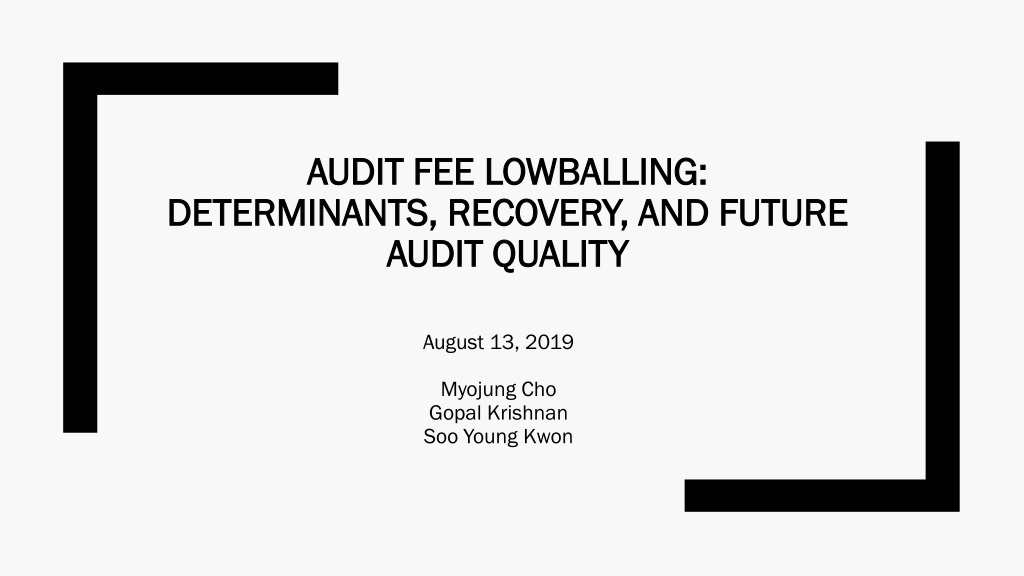
 undefined
undefined









